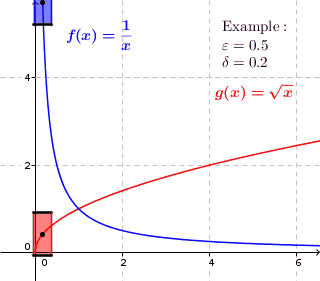
Back Равномерна непрекъснатост Bulgarian Continuïtat uniforme Catalan Stejnoměrně spojitá funkce Czech Di-dorredd unffurf Welsh Gleichmäßige Stetigkeit German Ομοιόμορφη συνέχεια Greek Continuidad uniforme Spanish Ühtlane pidevus Estonian پیوستگی یکنواخت Persian Tasainen jatkuvuus Finnish

In mathematics, a real function of real numbers is said to be uniformly continuous if there is a positive real number such that function values over any function domain interval of the size are as close to each other as we want. In other words, for a uniformly continuous real function of real numbers, if we want function value differences to be less than any positive real number , then there is a positive real number such that at any and in any function interval of the size .
The difference between uniform continuity and (ordinary) continuity is that, in uniform continuity there is a globally applicable (the size of a function domain interval over which function value differences are less than ) that depends on only , while in (ordinary) continuity there is a locally applicable that depends on both and . So uniform continuity is a stronger continuity condition than continuity; a function that is uniformly continuous is continuous but a function that is continuous is not necessarily uniformly continuous. The concepts of uniform continuity and continuity can be expanded to functions defined between metric spaces.
Continuous functions can fail to be uniformly continuous if they are unbounded on a bounded domain, such as on , or if their slopes become unbounded on an infinite domain, such as on the real (number) line. However, any Lipschitz map between metric spaces is uniformly continuous, in particular any isometry (distance-preserving map).
Although continuity can be defined for functions between general topological spaces, defining uniform continuity requires more structure. The concept relies on comparing the sizes of neighbourhoods of distinct points, so it requires a metric space, or more generally a uniform space.
© MMXXIII Rich X Search. We shall prevail. All rights reserved. Rich X Search














